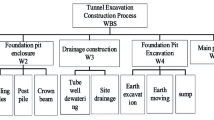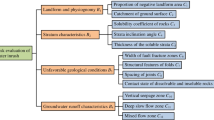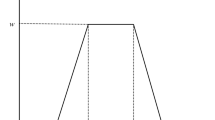Abstract
Constructing super-sized quasi-rectangular pipe-jacking tunnels beneath high-speed railways presents a significant risk to both the railways and the tunnels. This paper uses expert inquiry, numerical simulation, fuzzy comprehensive evaluation, and on-site monitoring to assess and control risks for constructing a super-sized quasi-rectangular pipe-jacking tunnel project beneath high-speed railways. An assessment system including 18 factors from 6 aspects is built by integrating existing literature, expert consultation, and causality analysis. As the insufficient number of projects, the Analytic Hierarchy Process (AHP), Fuzzy Comprehensive Evaluation Method (FCEM), Delphi method, and numerical simulation are employed to establish a risk assessment model. The pre-support roof construction (P-SRC) technology is proposed to control tunnel construction risks. The actual scenario on site examines the validity and practicality of the evaluation model and control measures. The results indicate that the super-sized quasi-rectangular pipe-jacking tunnel sections for planned and operational high-speed railways belong to the level I risk, requiring risk reduction measures. The artificial borehole piles + D-shaped beams scheme and pile-plate structure scheme decrease the construction risk from level I to IV, and the evaluated risk results and control effect are in good agreement with actual construction conditions. The proposed risk assessment method and control technology are reasonable and reliable, providing a scientific reference for similar projects.
Similar content being viewed by others
References
Chen J, Huang H, Cohn AG, Zhang D, Zhou M (2022) Machine learning-based classification of rock discontinuity trace: SMOTE oversampling integrated with GBT ensemble learning. International Journal of Mining Science and Technology 32(2):309–322, DOI: https://doi.org/10.1016/j.ijmst.2021.08.004
Editorial Department of China Journal of Highway and Transport (2022) Review on China’s traffic tunnel engineering research: 2022 Zhongguo Gonglu Xuebao/China. Journal of Highway and Transport 35:1–40, DOI: https://doi.org/10.19721/j.cnki.1001-7372.2022.04.001
Gao Y, Feng C-Y, Cheng P (2018) Overall-carrying-soil effect of shallow buried rectangular pipe jacking Yantu Gongcheng Xuebao/Chinese. Journal of Geotechnical Engineering 40:1936–1942, DOI: https://doi.org/10.11779/CJGE201810022
Gao X, Kong C, Wu D, Lu F, Liu M, Wang H, Ren S (2023) Construction risk control technology of a large tunnel complex in urban area. Frontiers in Earth Science 10, DOI: https://doi.org/10.3389/feart.2022.1079405
Guo D, Song Z, Xu T, Zhang Y, Ding L (2022a) Coupling analysis of tunnel construction risk in complex geology and construction factors. Journal of Construction Engineering and Management 148(9), DOI: https://doi.org/10.1061/(asce)co.1943-7862.0002360
Guo Y, Zheng J, Zhang R, Yang Y (2022b) An evidence-based risk decision support approach for metro tunnel construction. Journal of Civil Engineering and Management 28(5):377–396, DOI: https://doi.org/10.3846/jcem.2022.16807
Huang Z, Argyroudis S, Zhang D, Pitilakis K, Huang H, Zhang D (2022a) Time-dependent fragility functions for circular tunnels in soft soils asce-asme. Journal of Risk and Uncertainty in Engineering Systems Part A-Civil Engineering 8(3), DOI: https://doi.org/10.1061/ajrua6.0001251
Huang Z, Zhang D, Pitilakis K, Tsinidis G, Huang H, Zhang D, Argyroudis S (2022b) Resilience assessment of tunnels: Framework and application for tunnels in alluvial deposits exposed to seismic hazard. Soil Dynamics and Earthquake Engineering 162, DOI: https://doi.org/10.1016/j.soildyn.2022.107456
Jiang X, Zhang X, Wang S, Bai Y, Huang B (2022) Case study of the largest concrete earth pressure balance pipe-jacking project in the world. Transportation Research Record 2676:92–105, DOI: https://doi.org/10.1177/03611981221076842
Kang Z, Yang W, Ying R, Deng E (2017) Construction risk identification and risk assessment of large rectangular shallow embedded shield pipe jacking tunnel. Journal of Railway Science and Engineering 14:1105–1112, DOI: https://doi.org/10.19713/j.cnki.43-1423/u.2017.05.030
Khazaei S, Shimada H, Matsui K, Kawai T, Yotsumoto J (2004) Over-cutting area control by using RADAR application in large diameter slurry pipe jacking method. In: ISRM International Symposium/3rd Asian Rock Mechanics Symposium (ARMS), Kyoto, JAPAN, 2004 Nov 30-Dec 02 2004, 633–638
Kim J, Kim C, Kim G, Kim I, Abbas Q, Lee J (2022) Probabilistic tunnel collapse risk evaluation model using analytical hierarchy process (AHP) and Delphi survey technique. Tunnelling and Underground Space Technology 120, DOI: https://doi.org/10.1016/j.tust.2021.104262
Lehmann G, Kaesling H, Cambier A, Praetorius S, Thuro K (2022) Performance analysis of utility tunneling data: A case study of pipe jacking in hard rock in Brittany. France Tunnelling and Underground Space Technology 127, DOI: https://doi.org/10.1016/j.tust.2022.104574
Li Z, Wang S, Cao Y, Ding R (2022) Dynamic risk evaluation method of collapse in the whole construction of shallow buried tunnels and engineering application. Mathematical Biosciences and Engineering 19:4300–4319, DOI: https://doi.org/10.3934/mbe.2022199
Lu X-Y, Xu C-S, Hou B-W, Du X-L, Li L-Y (2022) Risk assessment of metro construction based on dynamic bayesian network yantu gongcheng Xuebao/Chinese. Journal of Geotechnical Engineering 44:492–501, DOI: https://doi.org/10.11779/CJGE202203011
McCabe BA, Sheil BB, Phillips BM, O’Dwyer KG (2022) Discussion of “Experimental Study on the Pipe-Soil Interface under the Influence of Pipe Jacking Stagnation Time” by Tianliang Lia, Wen Zhaoa, Run Liua, Jianyong Hana and Cheng Chenga. KSCE Journal of Civil Engineering 26(8):3663–3664, DOI: https://doi.org/10.1007/s12205-022-2332-2
Meng G, Liu J, Qiu W, Wu B, Xu S (2022) A failure probability evaluation method for the collapse of drill-blast tunnels based on a multistate cloud bayesian network. Frontiers in Earth Science 10, DOI: https://doi.org/10.3389/feart.2022.856701
Meng G, Ye Y, Wu B, Luo G, Zhang X, Zhou Z, Sun W (2021) Risk assessment of shield tunnel construction in karst strata based on fuzzy analytic hierarchy process and cloud model. Shock and Vibration 2021, DOI: https://doi.org/10.1155/2021/7237136
Ministry of Housing and Urban-Rural Development of the People’s Republic of China (2011a) Code for risk management of underground works in urban rail transit. China Architecture & Building Press, Beijing
Ministry of Transport of the People’s Republic of China (2011) Guide for safety risk assessment of highway bridge and tunnel construction. China Construction Industry Press, Beijing
Ministry of Transport of the People’s Republic of China (2018) JTG 3370.1-2018 Specifications for design of highway tunnels section 1 civil engineering. China Communications Press Co. Ltd., Beijing
Ou L, Chen Y, Zhang J, Ma C (2022a) Dematel-ISM-based study of the impact of safety factors on urban rail tunnel construction projects. Computational Intelligence and Neuroscience 2022, DOI: https://doi.org/10.1155/2022/2222556
Ou G-Z, Jiao Y-Y, Zhang G-H, Zou J-P, Tan F, Zhang W-S (2021) Collapse risk assessment of deep-buried tunnel during construction and its application. Tunnelling and Underground Space Technology 115, DOI: https://doi.org/10.1016/j.tust.2021.104019
Ou X, Wu Y, Wu B, Jiang J, Qiu W (2022b) Dynamic bayesian network for predicting tunnel-collapse risk in the case of incomplete data. Journal of Performance of Constructed Facilities 36, DOI: https://doi.org/10.1061/(asce)cf.1943-5509.0001745
Qian Q, Chen J (2021) Analysis of tunneling risks of large-diameter shield and thoughts on its challenges. Tunnel Construction 41:157–164, DOI: https://doi.org/10.3973/j.issn.2096-4498.2021.02.001
Reed WR, Shahan MR, Zheng Y, Mazzella A (2021) Laboratory results of foam application testing for longwall shield dust control in a simulated environment. International Journal of Coal Science & Technology 8:217–227, DOI: https://doi.org/10.1007/s40789-021-00414-8
Sterling RL (2020) Developments and research directions in pipe jacking and rnicrotunneling. Underground Space 5:1–19, DOI: https://doi.org/10.1016/j.undsp.2018.09.001
Tang Y (2022) Research on risk assessment and management methods for projects of railway tunnels passing under expressways. Modern Tunnelling Technology 59:220–226, DOI: https://doi.org/10.13807/j.cnki.mtt.2022.03.025
Wang C, Peng Z, Gou C, Feng K, Wu W, Lin H (2017) Study on the influence zone partition method of shield tunnel-pile foundations approaching construction. Tumu Gongcheng Xuebao/China Civil Engineering Journal 50:174–181, DOI: https://doi.org/10.15951/j.tmgcxb.2017.s2.027
Wang H, Dong J, Wu Z, Wang Z (2020) The reference should be: Wang H, Dong J, Wu Z, Wang Z (2020) Impact of undercrossing tunnel on safety and stability of existing heavy-duty railway tunnel. Journal of the China Railway Society 42:102–111, DOI: https://doi.org/10.3969/j.issn.1001-8360.2020.06.014
Wang J, Cao A, Wu Z, Sun Z, Lin X, Sun L, Liu W, Liu X, Li H, Sun Y, Long Y (2021a) Dynamic risk assessment of ultra-shallow-buried and large-span double-arch tunnel construction. Applied Sciences-Basel 11(24), DOI: https://doi.org/10.3390/app1124T1721
Wang J-c, Liu J-q, Wei Q, Wang P (2021b) Risk assessment based on combined weighting-cloud model of tunnel construction. Tehnicki Vjesnik-Technical Gazette 28:203–210, DOI: https://doi.org/10.17559/tv-20200917163330
Wen K, Shimada H, Zeng W, Sasaoka T, Qian D (2020) Frictional analysis of pipe-slurry-soil interaction and jacking force prediction of rectangular pipe jacking. European Journal of Environmental and Civil Engineering 24:814–832, DOI: https://doi.org/10.1080/19648189.2018.1425156
Wu T-y, Jiang N, Zhou C-b, Xia Y-q, Zhang Y-q, Zhu B (2021) Analysis model for deformation mechanism of strip foundation of building: Considering shear effect of down-crossing tunnel under excavation. Journal of Central South University 28:2556–2573, DOI: https://doi.org/10.1007/s11771-021-4786-7
Wu B, Qiu W, Huang W, Meng G, Huang J, Xu S (2022) Dynamic risk evaluation method for collapse disasters of drill-and-blast tunnels: A case study. Mathematical Biosciences and Engineering 19:309–330, DOI: https://doi.org/10.3934/mbe.2022016
Xu Z, Cai N, Li X, Xian M, Dong T (2021) Risk assessment of loess tunnel collapse during construction based on an attribute recognition model. Bulletin of Engineering Geology and the Environment 80:6205–6220, DOI: https://doi.org/10.1007/s10064-021-02300-8
Yang Y, Wang Y, Easa SM, Yan X (2023) Risk factors influencing tunnel construction safety: Structural equation model approach. Heliyon 9:e12924–e12924, DOI: https://doi.org/10.1016/j.heliyon.2023.e12924
Yong-Sang L, Byung-Hyun C (2020) Comparison of high-speed railway in east asia focusing on Korea, Chian, and Japan. Journal of the Korean Society for Railway 23:895–905, DOI: https://doi.org/10.7782/jksr.2020.23.9.895
Zhang F (2022) Stability analysis of construction process of new tunnel passing through high-speed railway foundation. Journal of Railway Engineering Society 39:53–58, DOI: https://doi.org/10.3969/j.issn.1006-2106.2022.05.009
Zhang Q, Dai Z, Shi Y, Li T, Wang J, Wang T (2020) Key technologies for newly-built tunnel tunnelling through operated tunnel. Journal of Railway Engineering Society 37:58–63, DOI: https://doi.org/10.3969/j.issn.1006-2106.2020.06.012
Acknowledgments
Not Applicable
Author information
Authors and Affiliations
Corresponding author
Rights and permissions
About this article
Cite this article
Ma, J., Cui, G., He, S. et al. Assessment and Control of Construction Risk for a Super-Sized Quasi-Rectangular Pipe-Jacking Tunnel Adjacently to High-Speed Railways: A Case Study. KSCE J Civ Eng 27, 4520–4533 (2023). https://doi.org/10.1007/s12205-023-0435-z
Received:
Revised:
Accepted:
Published:
Issue Date:
DOI: https://doi.org/10.1007/s12205-023-0435-z




